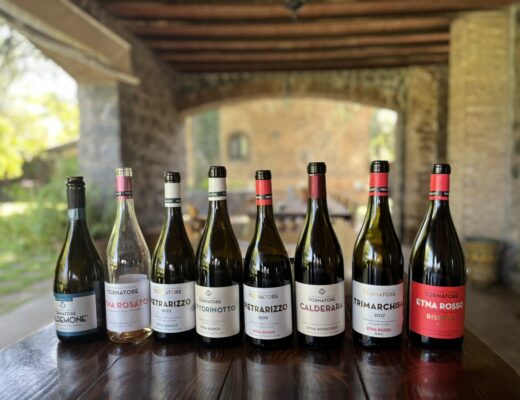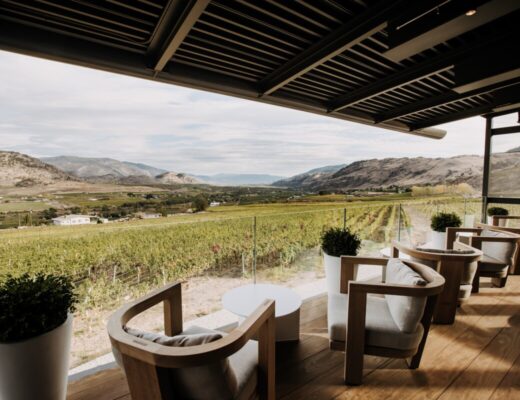“If pinot noir is the king of wines, then gamay noir is the knight.”
This analogy to chess by Thomas Bachelder is an astute synopsis of how this ‘Bojo’ (Beaujolais) grape is playing a more important role in Ontario’s wine industry.
Once upon a time gamay was a “cash cow” for Ontario growers: an inexpensive grape that yielded abundantly and was used by many wineries as a filler or blending partner for their more popular red wines.
Read Also: Yours to Discover: Ontario’s pinot gris breaks away from neutral territory
Today, however, thanks to the leadership of winemakers like Shiraz Mottiar (Malivoire Wine Co.), Thomas Bachelder (Bachelder Wines), and Jean-Pierre Colas (13th Street Winery) among others, gamay is increasingly bottled as a single varietal wine.
In fact, there are approximately 550 acres planted to gamay and talk among growers is that this will increase. It still only accounts for three percent of total volume of Ontario wine produced in 2022; by comparison, pinot noir clocks in at six percent, while cabernet franc and merlot both make up 11percent apiece. Currently, about 20 percent of Ontario wineries produce single varietal gamay noir, with some producers offering a range of single vineyard expressions and styles. Interestingly, Ontario has the most vineyard space devoted to gamay outside of Beaujolais, with Switzerland in third spot.

Mapping Niagara’s terroir.
Gamay’s popularity among wine consumers, winemakers and grape growers is not really a recent development.
Over a decade ago, Dr. Janet Dorozynski (Trade Commissioner, Global Affairs Canada, and sector lead for Canadian wine, beer and spirits) came up with #gogamaygo to bolster gamay’s potential as a signature Ontario grape.
While globally there is a significant downward trend in supply and demand for red wine (mostly heavy and tannin-rich red wines), wine consumers, especially younger generations, have turned to white wines, rosé wines, and sparkling wines, along with lighter, aromatic, chillable reds. Enter gamay!
Winemakers and grape growers have known for a long time about gamay’s winter hardiness. They were recently reminded when severe weather events damaged other vinifera varieties and left gamay noir unscathed. Additionally, it suits Ontario’s short growing season as it ripens early and consistently. The thick skinned gamay is also less prone to fungal diseases. It is, however, a highly productive grapevine and needs to be thinned during the growing season, leaving fewer bunches of fruit in order to make quality wine.

Malivoire’s Shiraz Mottiar.
Shiraz Mottiar, affectionately called the “king of gamay” by industry folk, says they drop 50 percent of the fruit on the 23 acres of gamay vines at Malivoire. That way, the remaining fruit acquires the necessary sugars, colour, and flavour intensity he looks for in Malivoire’s seven single varietal bottlings of gamay wines.
While several Malivoire gamay wines showcase single vineyards, Shiraz (now team principal & GM) and new head winemaker Elisa Mazzi also focus on experimenting and having fun with gamay during the winemaking process.
This involves a variety of fermentation vessels (oak or concrete vats, stainless steel tanks), wild and cultured yeasts, destemmed, whole-berry, and crushed fruit fermentations or semi-carbonic, and a range of ageing time for the wines from six to 15 months.
For Shiraz, who has travelled through Beaujolais, France studying their growing and winemaking practices with gamay noir, it’s about producing a wine that is juicy, accessible and not too cerebral. He does not like overt oak notes in gamay as they mask its fruity personality. In fact he notes that in Bojo, winemakers mostly use concrete vats for fermentation. Hence, when visiting Malivoire, look for the three concrete tanks on the outside of the production cellar used to produce several of their gamay wine offerings.

A tasting with Thomas Bachelder.
When asked why gamay wine seems to be trending, Shiraz credits sommeliers for bringing attention to it as well as the natural and organic wine movement in France, centred in Beaujolais.
In many ways, Thomas Bachelder shares Shiraz’ passion for gamay noir (as with all things Bourgogne). Gamay noir entered Thomas’ portfolio of wines when pinot noir became harder to secure from growers, as every winery wants to make pinot noir wines.
Thomas’ wines are all about terroir and how his grapes of choice – chardonnay, pinot noir and gamay noir – express those terroirs. The Bachelders (Thomas and wife Mary) have been mapping Niagara’s single vineyard terroirs since 2017 and love experimenting with production techniques. Currently there are eight Cru Niagara Gamays.

A tasting of Bachelder’s Gamay wines.
With gamay noir, his preference is 30 percent whole cluster mixed with destemmed fruit to bring out terroir. The resulting wines show a balance of luscious fruit and gravel like minerality stemming from the glacial till soils found throughout Niagara. Further to Thomas’ recipe for gamay wines is indigenous yeast fermentation, low sulphur additions, ageing for 17 months (on average) in neutral oak barrels and consistently keeping the same barrels for the same vineyards – even his barrel cellar is organized in a consistent fashion with wine in barrel from Niagara’s easternmost vineyards to westernmost.
For Bachelder, gamay noir wines are convivial when young and elixir when two to five years old, with just enough complexity to keep one interested. He also loves the crunchy acidity of gamay. Thomas thinks that now there is a critical mass of producers getting gamay right and that it will put Niagara on the map globally – not just for gamay – but as a wine region.

13th Street Winery’s Gamay bottlings.
Perhaps the gamay noir pioneers were the founders of 13th Street Winery (est. 1998) which is now owned by Doug and Karen Whitty and John and June Mann. Doug Whitty credits the founders (wine lovers and amateur winemakers, Ken Douglas, Erv Willms, Gunther Funk and Herb Jacobson) for having the vision to focus on sparkling and small parcel, handcrafted, full-bodied gamay wines. Whitty goes on to say that the once under-appreciated gamay noir is now a “bona fide crown jewel of wine” in Niagara.
There are seven acres planted to gamay at 13th Street Winery and winemaker Jean-Pierre Colas is certainly showcasing the versatility of this grape variety. The winery produces a sparkling wine, Blanc de Noir, from gamay as well as a very light rosé, Vin Gris, a structured top tier, Gamay Sandstone, a gulpable entry level gamay, and a juicy blend of gamay and pinot noir, Burger Blend.
JP Colas’ winemaking approach with gamay is to let the character of the grape variety shine through without the over-abundance of oak influence or intervention.
So, from fruity and fun to seriously quaffable, gamay’s versatility and ability to showcase Niagara terroir is a testament to its trending popularity. As Doug Whitty quips, “it’s a heart-warming grape” as opposed to pinot noir that is often called the heartbreak grape. Also noteworthy is gamay’s lower alcohol and better price positioning.
The time has come for gamay to make its move as one of Ontario’s signature grape varieties.
Malivoire 2022 ‘Le Coeur’ Gamay
The wine was made using whole grape clusters and carbonic maceration which produces perfumed, fruity, easy-drinking wines often with confectionary like aromas and flavours … in this case cinnamon heart candies (as described in the winery’s tasting notes, with which I concur)! Look for aromas of violets, raspberry, cherry, and some savoury tea leaf notes. The palate is bright, with sour cherry and pomegranate fruit, silky tannins and a peppery finish. A wine that is “croquant” in the best possible way. ($32)
Malivoire 2021 ‘Courtney’ Gamay
This top tier Malivoire gamay comes from the exceptional Courtney block vineyard on the estate. Given extended hang time for ripening as well as longer ageing in barrel (with some new oak), the wine is crafted in the Burgundian method. This refers to using destemmed fruit and more extraction. It has aromas of black cherry, plum, vanilla and a hint of cocoa. On the palate, the wine is silky, round, bright, with notes of cherry filled chocolate, red berries, and finishes with some pepper spice. A round, balanced and complex wine. ($35)
Bachelder 2021 ‘Bai Xu’ Niagara Cru
From Four-Mile Creek sub-appellation and old vines (planted in 1981), this is a savoury, earthy and stony-crunchy wine. Made with 32% whole bunch fruit mixed with destemmed berries, aged for 17 months in neutral French oak, the wine shows brambly dark fruit on the nose and palate. It’s a beautifully textured wine, lithe but rich, with a tangy finish. ($32)
Bachelder 2021 ‘Wismer-Foxcroft’ Niagara Cru
Coming from the sub-appellation of Twenty Mile Bench, this wine speaks of flinty minerality and gravelly crunch. Made with 33% whole cluster fruit mixed with destemmed berries, aged for 17 months in neutral oak barrels, this wine opens with cherry and redcurrant aromas with some edgy savoury spice. The palate offers black cherry and blackberry, dark chocolate and anise along with a solid backbone of acidity and silky tannins that grip on the long finish. An energetic and savoury wine. ($33)
13th Street 2021 Gamay Blanc de Noir
Made using the traditional method, this is a lovely dry sparkler, 100% gamay fruit from the Whitty vineyard, and aged for 12 months on lees. Golden in colour, the wine bursts with aromas of biscuit, white raspberry, notes of strawberry-rhubarb pie and milk toffee. The palate opens with a fine mousse, satiny texture, bright acidity and flavours of red apple, cherry and lemon. The finish is long with a mineral salinity. ($34.95)
13th Street 2021 ‘Sandstone’ Gamay
Reminiscent of Bojo’s Grand Cru wines, this is a serious and complex gamay. Aromas of ripe raspberry, red plum, vanilla and black pepper are followed by black cherry, plum, pomegranate, pepper spice with and underlay of savoury herbs on the palate. The texture is smooth and the finish is long. It’s a beautifully balanced wine. ($35)
![]()













